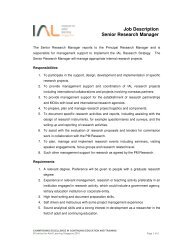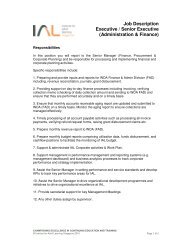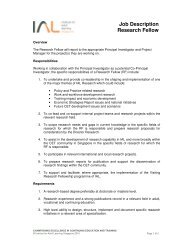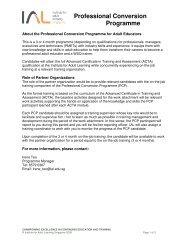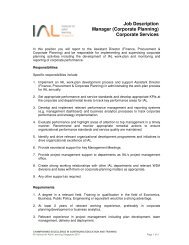Challenges affecting the integration of competency-based training at ...
Challenges affecting the integration of competency-based training at ...
Challenges affecting the integration of competency-based training at ...
You also want an ePaper? Increase the reach of your titles
YUMPU automatically turns print PDFs into web optimized ePapers that Google loves.
innov<strong>at</strong>ively and flexibly by engaging <strong>the</strong>ir learners through enhancing <strong>the</strong>irlearning experience. In my opinion, <strong>the</strong> challenge for WDA <strong>the</strong>n, is to find abalance within its implement<strong>at</strong>ion str<strong>at</strong>egy in achieving its outcomes for higherlevels <strong>of</strong> pedagogic capability among WSQ trainers and teachers, between itsuse <strong>of</strong> regul<strong>at</strong>ory enforcement measures versus efforts to pr<strong>of</strong>essionalise <strong>the</strong>role <strong>of</strong> Adult Educ<strong>at</strong>ors through a mix <strong>of</strong> recognition and rewards, as part <strong>of</strong> itsquest to achieve a high quality <strong>of</strong> programmes for <strong>the</strong> CET community (bothWSQ and non-WSQ) which are able to address <strong>the</strong> needs <strong>of</strong> its learners in <strong>at</strong>a holistic level.ConclusionBased on <strong>the</strong> review <strong>of</strong> liter<strong>at</strong>ure and analysis <strong>of</strong> findings, it is possible toconclude th<strong>at</strong> <strong>the</strong> WSQ system has inherited <strong>the</strong> narrow form <strong>of</strong> competencefrom <strong>the</strong> original NVQ model and such a performance-orient<strong>at</strong>ed assessmentstructure stands in <strong>the</strong> way <strong>of</strong> integr<strong>at</strong>ing CBT approach for <strong>the</strong> development<strong>of</strong> higher level programmes for <strong>the</strong> WSQ system. Singapore is <strong>at</strong> a similarstage <strong>of</strong> NQF CBT evolution as experienced by UK and Australia before.Current WSQ practitioners appear to lack sufficient pedagogic knowledge andexperience to support <strong>the</strong> development and implement<strong>at</strong>ion <strong>of</strong> a holistic CBTcurriculum which is customised to serve <strong>the</strong> gradu<strong>at</strong>e pr<strong>of</strong>ile <strong>of</strong> its learnersand <strong>the</strong> longer term employability needs <strong>of</strong> employers, while meeting <strong>the</strong>outcomes set by <strong>the</strong> standard. Instead, <strong>the</strong> current WSQ programmesdeveloper’s primary goal appears to be orchestr<strong>at</strong>ed around meeting WDA’scourse accredit<strong>at</strong>ion requirements while rigidly adhering to <strong>the</strong> WSQ principles<strong>of</strong> open access, bite-sized learning, and principles <strong>of</strong> assessment and rules <strong>of</strong>evidence. I would argue th<strong>at</strong> such a bite-sized, performance-orient<strong>at</strong>edassessment focus has resulted overwhelmingly in <strong>the</strong> cre<strong>at</strong>ion <strong>of</strong> fragmentedWSQ programmes which tend to closely mirror <strong>the</strong> performance criteria <strong>of</strong> <strong>the</strong><strong>competency</strong> standards ra<strong>the</strong>r th<strong>at</strong> to be organised around a suite <strong>of</strong> learningand assessment methods most suited for <strong>the</strong> pr<strong>of</strong>ile <strong>of</strong> <strong>the</strong> learners.One way for WDA to address <strong>the</strong> deficiencies <strong>of</strong> <strong>the</strong> NQF form <strong>of</strong> competenceidentified would be to consider incorpor<strong>at</strong>ing <strong>the</strong> best practices from o<strong>the</strong>r<strong>the</strong>ories rel<strong>at</strong>ed to <strong>the</strong> subject <strong>of</strong> skills and competence such as <strong>the</strong> ―Fivestagemodel <strong>of</strong> adult skill acquisition‖ developed by Dreyfus and Dreyfus(1986) and <strong>the</strong> concepts <strong>of</strong> Communities <strong>of</strong> Practice (CoP) and SocialLearning Systems (Wenger, 2000) coupled with Situ<strong>at</strong>ed Learning: Legitim<strong>at</strong>ePeripheral Particip<strong>at</strong>ion developed by Lave and Wenger (1991), to use WSQ<strong>competency</strong> standards as <strong>the</strong> basis <strong>of</strong> a wider holistic CBT curriculum to meet<strong>the</strong> respective needs <strong>of</strong> learners, employers and industry.A much gre<strong>at</strong>er level <strong>of</strong> learning and assessment through <strong>the</strong> WSQ systemwould be possible through <strong>the</strong> adoption <strong>of</strong> a broader and holistic definition,applied to WSQ <strong>competency</strong> standards and scaffold towards facilit<strong>at</strong>ing <strong>the</strong>novice learner’s entry and progression into an occup<strong>at</strong>ion or pr<strong>of</strong>ession.Essentially <strong>the</strong> WSQ system can assist learners who are new to an industry orsector enter as ―novices‖ through <strong>the</strong> <strong>at</strong>tainment <strong>of</strong> entry level or lower levelWSQ competencies for th<strong>at</strong> job. However, ra<strong>the</strong>r than viewing <strong>the</strong> ―novice‖learner as having met <strong>the</strong> entry level requirements for a job, WSQpractitioners should take a more holistic developmental approach to considerCopyright © 2011 Institute for Adult Learning 9




